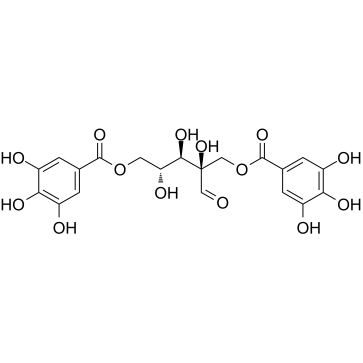金缕梅单宁

金缕梅单宁结构式

|
常用名 | 金缕梅单宁 | 英文名 | Hamamelitannin |
|---|---|---|---|---|
| CAS号 | 469-32-9 | 分子量 | 484.364 | |
| 密度 | 1.8±0.1 g/cm3 | 沸点 | 941.7±65.0 °C at 760 mmHg | |
| 分子式 | C20H20O14 | 熔点 | 145-147ºC | |
| MSDS | 中文版 美版 | 闪点 | 329.0±27.8 °C |
|
Quorum sensing inhibitors increase the susceptibility of bacterial biofilms to antibiotics in vitro and in vivo.
Antimicrob. Agents Chemother. 55 , 2655-2661, (2011) Although the exact role of quorum sensing (QS) in various stages of biofilm formation, maturation, and dispersal and in biofilm resistance is not entirely clear, the use of QS inhibitors (QSI) has been proposed as a potential antibiofilm strategy. We have inv... |
|
|
Hamamelitannin from witch hazel (Hamamelis virginiana) displays specific cytotoxic activity against colon cancer cells.
J. Nat. Prod. 75 , 26-33, (2012) Hamamelis virginiana (witch hazel) bark is a rich source of condensed and hydrolyzable tannins reported to exert a protective action against colon cancer. The present study characterizes different witch hazel tannins as selective cytotoxic agents against colo... |
|
|
Cerium, chitosan and hamamelitannin as novel biofilm inhibitors?
J. Antimicrob. Chemother. 67 , 1159-62, (2012) The colonization of indwelling medical devices and subsequent biofilm formation represents a global challenge since it promotes the persistence of infection and contributes to antimicrobial resistance. The aim of this study was to determine the antimicrobial ... |
|
|
Genotoxic and antigenotoxic effects of catechin and tannins from the bark of Hamamelis virginiana L. in metabolically competent, human hepatoma cells (Hep G2) using single cell gel electrophoresis.
Phytochemistry 63(2) , 199-207, (2003) The genotoxic and antigenotoxic activities of catechin, hamamelitannin and two proanthocyanidin fractions prepared from the bark of Hamamelis virginiana L. were investigated in a human derived, metabolically competent hepatoma cell line (Hep G2) using single ... |
|
|
Discovery of a quorum-sensing inhibitor of drug-resistant staphylococcal infections by structure-based virtual screening.
Mol. Pharmacol. 73(5) , 1578-86, (2008) Staphylococci are a major health threat because of increasing resistance to antibiotics. An alternative to antibiotic treatment is preventing virulence by inhibition of bacterial cell-to-cell communication using the quorum-sensing inhibitor RNAIII-inhibiting ... |
|
|
In vivo antibiofilm effect of cerium, chitosan and hamamelitannin against usual agents of catheter-related bloodstream infections.
J. Antimicrob. Chemother. 68(1) , 126-30, (2013) Catheter-related bloodstream infections (CRBSIs) are common healthcare-associated infections associated with increased morbidity and medical costs. Antiseptic- and antibiotic-coated central venous catheters (CVCs) have been proposed to reduce the incidence of... |
|
|
Protective activity of hamamelitannin on cell damage of murine skin fibroblasts induced by UVB irradiation.
J. Dermatol. Sci. 10(1) , 25-34, (1995) The protective activities of hamamelitannin (2',5-di-O-galloyl-hamamelose) in Hamamelis virginiana L. and its related compound, gallic acid, on damaged murine skin fibroblasts induced by UVB irradiation were investigated. In order to exclude the UV absorbing ... |
|
|
Determination of hamamelitannin, catechins and gallic acid in witch hazel bark, twig and leaf by HPLC.
J. Pharm. Biomed. Anal. 33(4) , 539-44, (2003) An HPLC method for the determination of hamamelitannin, catechins and gallic acid in witch hazel bark, twig and leaf has been developed. The separation system consisted of a C18 reversed-phase column, a gradient elution system of methanol/water and orthophosp... |
|
|
Peroxynitrite scavenging activity of herb extracts.
Phytother Res. 16(4) , 364-7, (2002) Peroxynitrite (ONOO(-)) is a cytotoxicant with strong oxidizing properties toward various cellular constituents, including sulphydryls, lipids, amino acids and nucleotides and can cause cell death, lipid peroxidation, carcinogenesis and aging. The aim of this... |
|
|
Suppression of biofilm related, device-associated infections by staphylococcal quorum sensing inhibitors.
Int. J. Artif. Organs 31(9) , 761-70, (2008) Staphylococcal spp. are notorious for causing biofilm-related device-associated infections, leading to tens of thousands of deaths per year. In this paper, we review quorum sensing inhibitors as potential therapeutics for even the most persistent infections. ... |